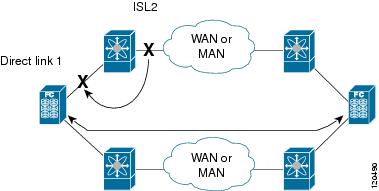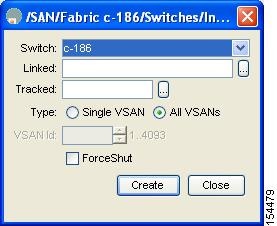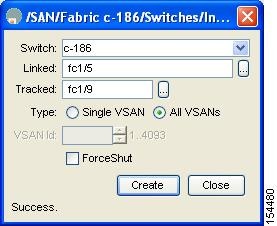- Device Manager Help
- Configuring Cisco DCNM-SAN Server
- Configuring Authentication in Cisco DCNM-SAN
- Configuring Cisco DCNM-SAN Client
- Device Manager
- Configuring Performance Manager
- Configuring High Availability
- Configuring Trunking
- Configuring PortChannels
- Configuring N Port Virtualization
- Configuring Interfaces
- Configuration of Fibre Channel Interfaces
- Using the CFS Infrastructure
- Configuring SNMP
- Configuring Domain Parameters
- Configuring and Managing Zones
- Configuring FCoE
- Configuring Dense Wavelength Division Multiplexing
- Configuring and Managing VSANs
- Discovering SCSI Targets
- Configuring SAN Device Virtualization
- Configuring Fibre Channel Routing Services and Protocols
- Managing FLOGI, Name Server, FDMI, and RSCN Databases
- Configuring FICON
- Creating Dynamic VSANs
- Distributing Device Alias Services
- Configuring Advanced Fabric Features
- Configuring Users and Common Role
- Configuring Security Features on an External AAA Server
- Configuring Certificate Authorities and Digital Certificates
- Configuring FC-SP and DHCHAP
- Configuring Cisco TrustSec Fibre Channel Link Encryption
- Configuring FIPS
- Configuring IPv4 and IPv6 Access Control Lists
- Configuring IPsec Network Security
- Configuring Port Security
- Configuring Fabric Binding
- Configuring FCIP
- Configuring the SAN Extension Tuner
- Configuring iSCSI
- Configuring IP Services
- Configuring IP Storage
- Configuring IPv4 for Gigabit Ethernet Interfaces
- Configuring IPv6 for Gigabit Ethernet Interfaces
- Configuring SCSI Flow Services
- Configuring SCSI Flow Statistics
- Configuring Fibre Channel Write Acceleration
- Monitoring the Network
- Monitoring Performance
- Configuring Call Home
- Configuring System Message Logging
- Scheduling Maintenance Jobs
- Configuring RMON
- Configuring Fabric Configuration Server
- Monitoring Network Traffic Using SPAN
- Monitoring System Processes and Logs
- Configuring QoS
- Configuring Port Tracking
- Configuring FlexAttach Virtual pWWN
- Configuring Interface Buffers
- Verifying Ethernet Interfaces
- Information About Port Tracking
- Guidelines and Limitations
- Default Settings
- Configuring Port Tracking
- Enabling Port Tracking
- Information About Configuring Linked Ports
- Binding a Tracked Port Operationally
- Information About Tracked Port
- Information About Tracking Multiple Ports
- Tracking Multiple Ports
- Information About Monitoring Ports in a VSAN
- Monitoring Ports in a VSAN
- Information About Forceful Shutdown
- Forcefully Shutting Down a Tracked PortDetailed Steps
Configuring Port Tracking
The port tracking feature is unique to the Cisco MDS 9000 Family of switches. This feature uses information about the operational state of the link to initiate a failure in the link that connects the edge device. This process of converting the indirect failure to a direct failure triggers a faster recovery process towards redundant links. When enabled, the port tracking feature brings down the configured links based on the failed link and forces the traffic to be redirected to another redundant link.
Information About Port Tracking
The Port Tracking feature is unique to the Cisco MDS 9000 Family of switches. This feature uses information about the operational state of the link to initiate a failure in the link that connects the edge device. This process of converting the indirect failure to a direct failure triggers a faster recovery process towards redundant links. Generally, hosts can instantly recover from a link failure on a link that is immediately (direct link) connected to a switch. However, recovering from an indirect link failure between switches in a WAN or MAN fabric with a keep-alive mechanism is dependent on several factors such as the time out values (TOVs) and on registered state change notification (RSCN) information. When enabled, the port tracking feature brings down the configured links based on the failed link and forces the traffic to be redirected to another redundant link.
The port tracking feature is disabled by default in all switches in the Cisco 9000 Family. When you enable this feature, port tracking is globally enabled for the entire switch.
Generally, hosts can instantly recover from a link failure on a link that is immediately (direct link) connected to a switch. However, recovering from an indirect link failure between switches in a WAN or MAN fabric with a keep-alive mechanism is dependent on several factors such as the time out values (TOVs) and on registered state change notification (RSCN) information.
In Figure 58-1, when the direct link 1 to the host fails, recovery can be immediate. However, when the ISL 2 fails between the two switches, recovery depends on TOVs, RSCNs, and other factors.
Figure 58-1 Traffic Recovery Using Port Tracking

The port tracking feature monitors and detects failures that cause topology changes and brings down the links connecting the attached devices. When you enable this feature and explicitly configure the linked and tracked ports, the Cisco NX-OS software monitors the tracked ports and alters the operational state of the linked ports on detecting a link state change.
The following terms are used in this chapter:
- Tracked ports—A port whose operational state is continuously monitored. The operational state of the tracked port is used to alter the operational state of one or more ports. Fibre Channel, VSAN, PortChannel, FCIP, or a Gigabit Ethernet port can be tracked. Generally, ports in E and TE port modes can also be Fx ports.
- Linked ports—A port whose operational state is altered based on the operational state of the tracked ports. Only a Fibre Channel port can be linked.
Guidelines and Limitations
Before configuring port tracking, consider the following guidelines:
- Verify that the tracked ports and the linked ports are on the same Cisco MDS switch.
- Do not track a linked port back to itself (for example, Port fc1/2 to Port fc2/5 and back to Port fc1/2) to avoid recursive dependency.
- Be aware that the linked port is automatically brought down when the tracked port goes down. Be aware that the linked port is automatically brought down when the tracked port goes down.
Default Settings
Table 58-1 lists the default settings for port tracking parameters.
Configuring Port Tracking
Port tracking has the following features:
- The application brings the linked port down when the tracked port goes down. When the tracked port recovers from the failure and comes back up again, the tracked port is also brought up automatically (unless otherwise configured).
- You can forcefully continue to keep the linked port down, even though the tracked port comes back up. In this case, you must explicitly bring the port up when required.
This section includes the following topics:
- Enabling Port Tracking
- Information About Configuring Linked Ports
- Binding a Tracked Port Operationally
- Information About Tracking Multiple Ports
- Tracking Multiple Ports
- Information About Monitoring Ports in a VSAN
- Monitoring Ports in a VSAN
- Information About Forceful Shutdown
- Forcefully Shutting Down a Tracked PortDetailed Steps
Enabling Port Tracking
The port tracking feature is disabled by default in all switches in the Cisco 9000 Family. When you enable this feature, port tracking is globally enabled for the entire switch.
To configure port tracking, enable the port tracking feature and configure the linked port(s) for the tracked port.
To enable port tracking with Fabric Manager, follow these steps:
Step 1 Expand Switches , expand Interfaces , and then select Port Tracking in the Physical Attributes pane.
The port tracking information is displayed in the Information pane shown in Figure 58-2. The default is the Controls tab.

Step 2 Click in the Command column to enable or disable port tracking.
Depending on your selection the corresponding entry in the Status column changes.
Step 3 Click the Apply Changes icon t o save your changes .
The entry in the Result column changes to success .
Information About Tracked Port
A tracked port is one whose operational state is continuously monitored. The operational state of the tracked port is used to alter the operational state of one or more ports. Fibre Channel, VSAN, PortChannel, FCIP, or a Gigabit Ethernet port can be tracked. Generally, ports in E and TE port modes can also be Fx ports. Ports can be linked using one of the following two methods:
- Operationally binding the linked port(s) to the tracked port (default). Operational binding comes to effect automatically when you configure the first tracked port.
- Continuing to keep the linked port down forcefully—even if the tracked port has recovered from the link failure.
When you configure the first tracked port, operational binding is automatically in effect. When you use this method, you have the option to monitor multiple ports or monitor ports in one VSAN.
To operationally bind a tracked port, follow these steps:
Step 1 Expand Switches , expand Interfaces , and then select Port Tracking in the Physical Attributes pane.
The port tracking information is displayed in the Information pane. The default is the Controls tab.
Figure 58-3 Port Tracking Controls Tab

Step 2 Click the Dependencies tab.
You see the Create Port Tracking Dependencies dialog box shown in Figure 58-4.
Figure 58-4 Create Port Tracking Dependencies Dialog Box

Step 4 Select the switch whose ports you want to track by and selecting a switch from the drop-down list.
Step 5 Select the linked port(s) that should be bound to the tracked port(s) by clicking the browse button and selecting from the list.
Step 6 Click the Single VSAN radio button if you want to track these ports only in one VSAN or click the All VSANs radio button if you want to track these ports in all the available VSANs.
See “Information About Monitoring Ports in a VSAN” section for details.
Step 7 If you chose Single VSAN in the previous step, enter the ID of the VSAN where these ports will be monitored.
Step 8 Check the Forceshut check box if you want to forcefully shutdown the tracked port.
See “Information About Forceful Shutdown” section for details.
Step 9 Click Create to proceed with creating this dependency.
If tracking is established, you see Success in the lower left corner of the dialog box (see Figure 58-5).
Figure 58-5 Successful Port Tracking Established

Step 10 Click Close to close the dialog box.
To operationally bind a tracked port, follow these steps:
Configures the specified interface and enters the interface configuration submode. You can now configure tracked ports. Note This link symbolizes the direct link (1) in Figure 58-1. |
||
Tracks interface fc8/6 with interface port-channel 1. When port-channel 1 goes down, interface fc8/6 is also brought down. Note This link symbolizes the ISL (2) in Figure 58-1. |
||
Removes the port tracking configuration that is currently applied to interface fc8/6. |
Information About Tracking Multiple Ports
You can control the operational state of the linked port based on the operational states of multiple tracked ports. When more than one tracked port is associated with a linked port, the operational state of the linked port will be set to down only if all the associated tracked ports are down. Even if one tracked port is up, the linked port will stay up.
You can control the operational state of the linked port based on the operational states of multiple tracked ports. When more than one tracked port is associated with a linked port, the operational state of the linked port will be set to down only if all the associated tracked ports are down. Even if one tracked port is up, the linked port will stay up.
In Figure 58-6, only if both ISLs 2 and 3 fail, will the direct link 1 be brought down. Direct link 1 will not be brought down if either 2 or 3 are still functioning as desired.
Figure 58-6 Traffic Recovery Using Port Tracking

Tracking Multiple Ports
To track multiple ports, see “Binding a Tracked Port Operationally” section.follow these steps:
Configures the specified interface and enters the interface configuration submode. You can now configure tracked ports. Note This link symbolizes the direct link (1) in Figure 58-6. |
||
Tracks interface fc8/6 with interface port-channel 1. When port-channel 1 goes down, interface fc8/6 is also brought down. Note This link symbolizes the ISL (2) in Figure 58-6. |
||
Tracks interface fc8/6 with interface fcip 5. When FCIP 5 goes down, interface fc8/6 is also brought down. Note This link symbolizes the ISL (3) in Figure 58-6. |
Information About Monitoring Ports in a VSAN
You can optionally configure one VSAN from the set of all operational VSANs on the tracked port with the linked port by specifying the required VSAN. This level of flexibility provides higher granularity in tracked ports. In some cases, when a tracked port is a TE port, the set of operational VSANs on the port can change dynamically without bringing down the operational state of the port. In such cases, the port VSAN of the linked port can be monitored on the set of operational VSANs on the tracked port. If you configure this feature, the linked port is up only when the VSAN is up on the tracked port.
You can optionally configure one VSAN from the set of all operational VSANs on the tracked port with the linked port by specifying the required VSAN. This level of flexibility provides higher granularity in tracked ports. In some cases, when a tracked port is a TE port, the set of operational VSANs on the port can change dynamically without bringing down the operational state of the port. In such cases, the port VSAN of the linked port can be monitored on the set of operational VSANs on the tracked port.
If you configure this feature, the linked port is up only when the VSAN is up on the tracked port.

Tip The specified VSAN does not have to be the same as the port VSAN of the linked port.
Monitoring Ports in a VSAN
To monitor a tracked port in a specific VSAN, see “Binding a Tracked Port Operationally” section.follow these steps:
Information About Forceful Shutdown
If a tracked port flaps frequently, then tacking ports using the operational binding feature may cause frequent topology change. In this case, you may choose to keep the port in the down state until you are able to resolve the reason for these frequent flaps. Keeping the flapping port in the down state forces the traffic to flow through the redundant path until the primary tracked port problems are resolved. When the problems are resolved and the tracked port is back up, you can explicitly enable the interface.
If a tracked port flaps frequently, then tracking ports using the operational binding feature may cause frequent topology change. In this case, you may choose to keep the port in the down state until you are able to resolve the reason for these frequent flaps. Keeping the flapping port in the down state forces the traffic to flow through the redundant path until the primary tracked port problems are resolved. When the problems are resolved and the tracked port is back up, you can explicitly enable the interface.

Tip If you configure this feature, the linked port continues to remain in the shutdown state even after the tracked port comes back up. You must explicitly remove the forced shut state (by administratively bringing up this interface) of the linked port once the tracked port is up and stable.
Forcefully Shutting Down a Tracked PortDetailed Steps
To forcefully shut down a tracked port, see “Binding a Tracked Port Operationally” section.
 Feedback
Feedback